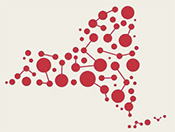Back to Dig Art!
Safety Tips
Art Materials to Avoid and Alternatives
Benefits of Environmentally-Friendly Arts Materials
Recipes for Natural Homemade Dyes and Paints
Additional Resources
Safety Tips
Reduce the harmful risks to children, you, and the environment by playing it safe and making some conscious choices when buying arts materials. Before buying the art materials that you need for an activity or project, begin by asking yourself the following questions:
- Are there any non-toxic, environmentally-friendly forms of this product?
- Can I make the art materials I need out of other ingredients (such as making homemade paints and natural dyes)?
- Are the art materials I will buy reusable, or only for one-time use?
- Can this project be made using locally found and recycled materials (leftover tiles from a tiling business, paint materials from paint shops, wood from construction companies, etc.)?
- Can this project be made using locally purchased materials?
Read labels first. If the product contains flag words such as poison, danger, warning, or caution, then its best to consider them unsafe for children.
Always follow directions. Pay attention to safety precautions and guidelines.
Buy small amounts. Purchase art supplies in smaller amounts to ensure that you’ll use everything you bought and that there won’t be any leftover waste to deal with.
Dispose materials properly. If you do have leftover materials, do NOT put toxic art materials in the trash – throwing them out in the regular garbage will mean that these toxic materials could leach into the environment! Contact your county’s local waste treatment and disposal unit for more information on proper disposal.
Always use products in their safest form. Choose liquids instead of powders and brush-ons rather than sprays. Buy your paints in a solid or liquid form so that you avoid exposure to dusts when mixing paints.
Work in a well ventilated area with an exhaust fan.
Keep containers sealed, with different classes of products separated.
Don’t eat or drink in the work area and never use toxic products on items which may contact food such as cutting boards, bowls, or kitchen counters.
top
Art Materials to Avoid and Alternatives
Click here for our Greener Arts Chart (pdf) that outlines art materials to avoid and safer alternatives.
Toxic Elements in Art Supplies:
Adhesives
The most toxic adhesives are contact cement, rubber cement, epoxy, instant glues, plastic adhesives and model glues. The solvents found in adhesives are extremely toxic – they emit vapors which are very hazardous when inhaled. Safer adhesive options include white wood glues and glue sticks.
Paints
Solvents are also used in oil-based paints. Reduce your exposure to solvents by using watercolors or other water-based paints. If you must use a solvent-based paint, choose thinners such as ethyl or isopropyl alcohol, acetone, or odorless mineral spirits which are less toxic than methyl alcohol, toluene, and turpentine.
Pigments
Both water-based and solvent-based paints may have pigments that contain highly toxic metals such as arsenic, cadmium or lead. Generally the most toxic pigments are used in professional artists’ paints because these are exempt from the hazard labeling law. Children and youth should be given only water-based children’s paints that are made with non-toxic pigments.
Note: Even though acrylic paints are water-based, they may contain small amounts of ammonia, formaldehyde, and acrylonitrile plastic.
top
Benefits of Environmentally-Friendly Arts Materials
Stay healthy and safe: Be confident by running your programs with the motto of ‘safety first’.
Protect the environment: Take pride in knowing your programs are environmentally-friendly.
Save money: In addition to being more environmentally-friendly, using salvaged recycled materials, homemade paints and natural dyes are cheaper alternatives to buying new synthetic materials.
Create unique products: Using salvaged and recycled materials gives a unique look to your art projects.
Easy to get: You can find eco-friendly art material substitutes easily!
Model resourcefulness: By modeling resourcefulness and other R’s (reduce, reuse, recycle, re-purpose) you are teaching your students life and stewardship skills that ripple far beyond the activity at hand.
Recipes for Natural Homemade Dyes and Paints
Natural Homemade Dyes
1/2 cup of plant material for desired color (see below)
1 cup of water
- Mix half a cup of plant material with one cup of water in a pan and bring to a boil.
- Simmer on low for half an hour, adding additional water as it evaporates.
- Mix colors together for different shades and hues of color.
Colorful natural plant materials
Brown: walnut hulls, paprika
Green: oak bark, crab apple leaves and bark
Orange: yellow onion skins, oats
Purple: purple grapes
Red: cranberries, beets (Note: you can use juice directly from thawed berries or canned beets)
Tan: coffee and tea
Yellow: apple tree bark, white onion skins, turmeric
For more natural plant materials used in making dyes, see Plants Used in Art Projects(pdf).
Natural Homemade Paints
1 cup of cornstarch
1/2 cup of water
1/3 cup of soap flakes melted with a half cup of boiling water
Natural homemade dyes
- Grate a homemade soap bar until you get a third cup of soap flakes.
- Combine cornstarch, water, and melted soap in a bowl.
- Stir well and let mixture set until thickened.
- Divide into separate bowls and add in natural dyes for color.
- Your paints are now ready for a canvas!
Recipes adapted from Better Basics for the Home by Annie Bond
Additional Resources
Non-Toxic Art Supplies
MAX Grumbacher Art supplies oil paints that clean up with water.
An article from Safer Chemicals, Healthy Families on where to find non-toxic art supplies.
Ideas for Recycled Art
Here are some ideas for creating recycled arts projects with a younger audience.
Articles on the toxic risk of art supplies
Washington Toxic Coalition’s Fact Sheet on Art and Hobby Supplies
Article: Are Art Supplies Toxic?
By law, US schools cannot give art supplies with any hazard warning to K-6 school children. Here is a list (pdf) of art materials that are not allowed for use by K-6 children, compiled by California Environmental Protection Agency.
Articles from Healthy Child Healthy World On How to Ensure Your Arts Supplies Are Ecological and Safe
Make Sure Your Child is Playing with Nontoxic Games, Arts & Crafts
Encourage Creativity with Healthy Art Supplies
top









